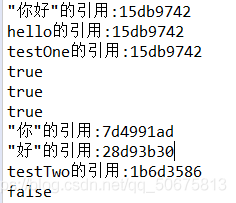JAVA把String类定义为final类(因此用户不能扩展String类,即String类不可以有子类)
String对象可以用"+"进行并置运算
identityHashCode会返回对象的hashCode,而不管对象是否重写了hashCode方法。
public class Example8_1 {public static void main(String args[]) {String hello = "你好";String testOne = "你"+"好"; //【代码1】int address =System.identityHashCode("你好");System.out.printf("\"你好\"的引用:%x\n",address);address =System.identityHashCode(hello);System.out.printf("hello的引用:%x\n",address);address =System.identityHashCode(testOne);System.out.printf("testOne的引用:%x\n",address);System.out.println(hello == testOne); //输出结果是trueSystem.out.println("你好" == testOne); //输出结果是trueSystem.out.println("你好" == hello); //输出结果是trueString you = "你";String hi = "好";String testTwo = you+hi; //【代码2】address =System.identityHashCode("你");System.out.printf("\"你\"的引用:%x\n",address);address =System.identityHashCode("好");System.out.printf("\"好\"的引用:%x\n",address);address =System.identityHashCode(testTwo);System.out.printf("testTwo的引用:%x\n",address);System.out.println(hello == testTwo); //输出结果是false}}
String类中的方法:
1.public int length():用来获取一个String对象的字符序列
int number=s1.length();
2.public boolean equals(String s)用于比较当前String 对象的字符序列是否与s指定的String对象的字符序列相同
System.out.println(s1.equals(s2));
3.public boolean startsWith(String s)
判断当前String对象的字符串序列的前缀是否是参数指定的String对象s的字符序列
public boolean endsWith(String s)
4.public int compareTo(String s)
按照字典序与参数指定的String对象S的字符串序列比较大小
单词的排序
用Array类自带的方法 Arrays.sort(b);
b里面有所有的单词组成的大字符串
package lg;import java.util.*;
public class Example8_3 {public static void main(String args[]) {String [] a={"melon","apple","pear","banana"};String [] b={"西瓜","苹果","梨","香蕉"};System.out.println("使用SortString类的方法按字典序排列数组a:");for(int i=0;i<a.length;i++) {System.out.print(" "+a[i]);}System.out.println(" ");SortString.sort(a);for(int i=0;i<a.length;i++) {System.out.print(" "+a[i]);}System.out.println("");System.out.println("使用类库中的Arrays类,按字典序排列数组b:"); Arrays.sort(b);for(int i=0;i<b.length;i++) {System.out.print(" "+b[i]);}}
}public class SortString {public static void sort(String a[]) {int count=0; for(int i=0;i<a.length-1;i++) {int saveMinIndex = i;for(int j=i+1;j<a.length;j++) { if(a[j].compareTo(a[saveMinIndex])<0) {saveMinIndex = j;}} String temp=a[i];a[i]=a[saveMinIndex];a[saveMinIndex]=temp;}}
}
5.public boolean contains(String s)
判断当前String的对象字符序列是否包含参数S的字符序列
6.public int indexOf(String s)
从当前String对象的字符序列的0索引位置开始检索首次出现str的字符序列的位置,并返回位置
public int lastIndexOf(String s)
从当前String对象的字符序列的0索引位置开始检索最后一次出现str的字符序列的位置,并返回位置
找不到返回-1
String tom = "I am a good cat";
tom.indexOf("a");//值是2
tom.lastIndexOf("a");//值是13
7.public String substring(int startpoint)
substring(int startpoint)方法是字符串对象调用该方法获得一个当前字符串的子串,该子串是从当前字符串的startpoint处截取到最后所得的字符串(注:字符串的起始位置是从0开始的,截取的时候startpoint位置的字符也被截取)
substring(int start,int end)
方法是获取一个当前字符串的子串,该子串是通过复制当前字符串start到end-1位置上的字符串(注:字符串的起始位置是从0开始)
8。public char charAt(int index)
charAt()方法是用来输出一个字符串中的单个字符,例如:
String s = “hello world”;
system.out.println(s.charAt(1));
输出的结果就为e







)


)



)


)

